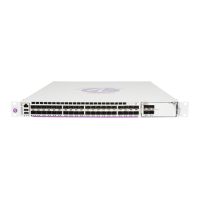IP Router Configuration
7705 SAR OS Router Configuration Guide 115
l4-load-balancing
Syntax l4-load-balancing {includeL4 | excludeL4}
no l4-load-balancing
Context config>router>interface
Description This command configures IP ECMP Layer 4 load balancing at the interface level. Configuration must
be done on the ingress network interface (that is, the interface on the node that the packet is received
on). When enabled, Layer 4 source and destination port fields of incoming TCP/UDP packets are
included in the hashing calculation to randomly determine which equal-cost path the packet will be
sent to.
You can add additional fields to generate more randomness and more equal distribution of packets with
the teid-load-balancing command.
The default configuration on the interface is to match the Layer 4 load balancing configuration in the
config>system context. Using this command to modify Layer 4 load-balancing configuration on an
interface overrides the system-wide load-balancing settings for that interface.
Parameters includeL4 — Layer 4 source and destination port fields are included in the hashing calculation
excludeL4 — Layer 4 source and destination port fields are not included in the hashing
calculation
ldp-sync-timer
Syntax ldp-sync-timer seconds
no ldp-sync-timer
Context config>router>interface
Description This command configures the IGP-LDP synchronization timer to enable synchronization of IGP and
LDP and synchronization of static routes and LDP. This command is not supported on RIP interfaces.
When a link is restored after a failure, IGP sets the link cost to infinity and advertises it. The supported
IGPs are OSPF and IS-IS. The value advertised in OSPF is 0xFFFF (65535). The value advertised in
IS-IS regular metric is 0x3F (63) and in IS-IS wide-metric is 0xFFFFFE (16777214).
After IGP advertises the link cost, the LDP hello adjacency is brought up with the neighbor. The LDP
synchronization timer is started by IGP from the time the LDP session to the neighbor is up over the
interface. This synchronization timer allows time for the label-FEC bindings to be exchanged.
When the LDP synchronization timer expires, the link cost is restored and is readvertised. IGP will
announce a new best next-hop and LDP will use it if the label binding for the neighbor’s FEC is
available.

